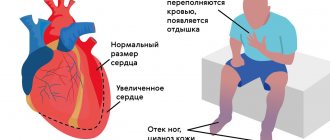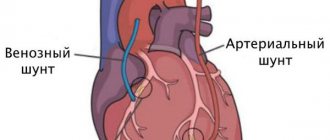01 Aug 2021 at 10:37 MRI of the heart in Tushino 8951
Atherosclerosis of the heart vessels is a disease in which fats and cholesterol are deposited in the form of plaques and deposits on the inner wall of blood arteries. As a result, the walls lose their elasticity and become compacted. As a result, the vessels become hard due to the fact that fats settle on their walls. The vessel may close completely. This process is accompanied by blood clotting disorders. People suffering from atherosclerosis are prone to thrombosis.
What is myocardial infarction?
Myocardial infarction is an acute form of coronary artery disease in which part of the heart muscle dies as a result of blockage of the coronary artery. Most often, myocardial infarction occurs as a result of the formation of a blood clot on the surface of an atherosclerotic plaque inside a coronary artery.
The mechanism of a heart attack is quite complex. One of the important factors is inflammation of the vascular wall in the area of the plaque. Oddly enough, blood clots most often form on small plaques, the covering of which cracks, which leads to thrombosis.
Diagnostics
Diagnosis of atherosclerosis of coronary vessels is carried out comprehensively and includes:
- Examination by a cardiologist. On it, the doctor records the patient’s complaints and conducts primary diagnostics, which boils down to listening to the rhythm, measuring blood pressure and an ECG.
- Stress scintigraphy. This study allows us to determine the location of lipid formations and the degree of their severity.
- Ultrasound with Doppler. Allows you to identify changes in the arteries, determine the thickness of their walls, evaluate hemodynamics and other important indicators.
- Coronary angiography. This study is conducted with contrast. It allows you to determine damage to the vascular walls and the degree of narrowing of the arteries of the heart.
- Pristress-ECHO. This study allows us to identify transient disorders of cardiac muscle contractility.
How do I know if I have IHD?
Symptoms: angina pectoris.
Often the first symptom of coronary artery disease is angina - chest pain associated with insufficient blood flow to the heart. Angina pectoris that occurs for the first time is very dangerous. It often leads to the development of myocardial infarction within 2-3 weeks. This condition requires urgent action. How to distinguish angina pectoris?
- The pain is most often localized behind the sternum - in the center of the chest.
- Pain occurs during physical activity and forces the patient to stop or at least slow down.
- When you stop, the pain goes away within 3-5 minutes.
If your symptoms are similar to angina pectoris, consult a doctor immediately; myocardial infarction may be only a few hours away.
If pain occurs in the left half of the chest, if it is associated with breathing, and lasts throughout the day, the likelihood of angina is minimal. However, only a doctor can make an accurate diagnosis.
Unfortunately, IHD often “debuts” with myocardial infarction, which can lead to irreversible consequences for the heart.
Causes of vascular atherosclerosis
Atherosclerosis of the coronary arteries can develop under the influence of endogenous and exogenous factors.
In total there are about 200 of them. The most common causes of pathology are:
- Increased cholesterol levels.
- Smoking.
- Arterial hypertension.
- Sedentary lifestyle.
- Obesity.
- Alcoholism.
- Age and gender. Men over 35-40 years of age are more susceptible to coronary artery pathologies. In women of reproductive age, the disease is quite rare. This is due to the synthesis of estrogens, which protect the arteries.
- Hereditary predisposition.
- Diabetes.
- Poor diet with a lot of animal fats.
How to recognize myocardial infarction?
Heaviness, burning, pressure, tearing pain behind the sternum are the most common symptoms of myocardial infarction. The pain often radiates to the neck, lower jaw, and left arm. Many patients report a feeling of lack of air and fear of death. It is very important to call an ambulance at the first symptoms. In large cities of Russia, a special network of hospitals has been created, on duty around the clock to treat patients with myocardial infarction. Unfortunately, the main reason for the poor results of this treatment is the late presentation of the patient.
Treatment of atherosclerosis
The treatment tactics are determined by the stage of the pathology, the patient’s condition and concomitant ailments.
When carrying out any manipulations, the patient should first of all:
- To refuse from bad habits.
- Normalize weight.
- Make time for regular moderate physical activity.
- Normalize nutrition. It is important to avoid fried, fatty and sweet foods. The diet should be supplemented with fresh vegetables and fruits, fermented milk products and water-based cereals.
Specialists use techniques that allow:
- Adjust blood pressure levels.
- Restore lipid and carbohydrate metabolism.
- Slow down pathological changes in the blood vessels of the heart.
- Reduce the oxygen demand of the heart muscle.
- Reduce the severity of ischemia.
In advanced cases, atherosclerosis of the coronary arteries can only be treated surgically.
Today, the following methods are used for effective treatment:
- Coronary artery bypass surgery. This technique allows you to create a bypass for blood flow. The affected area is not involved in blood circulation.
- Coronary stenting. This technique involves inserting a stent with a rigid frame into the affected artery. It allows you to expand the vascular bed and ensure the free passage of a sufficient amount of blood with oxygen and nutrients necessary for the heart muscle.
- Balloon angioplasty. This technique is one of the safest and most effective. A special catheter is inserted into the femoral artery. It is brought to the problem area. Then, at the site of the blockage of the artery, a balloon is inflated, which expands the existing lumen.
Modern methods of treating coronary atherosclerosis make it possible not only to eliminate the symptoms of the pathology, but also its causes. The choice in favor of a certain method should only be made by an experienced doctor. Do not self-medicate under any circumstances!
Contact our clinic in Moscow! We provide all services on the most favorable terms and at the best prices. The estimated cost of specialist consultation and examinations is indicated on the website. You can find out exact prices from specialists. Our medical center adheres to a loyal pricing policy. Thanks to this, therapy for any disease is available to all patients!
How can a doctor identify signs of IHD if there are no symptoms?
- It is possible that there are symptoms, but it is difficult for a lay person to assess them. For example, decreased exercise tolerance and shortness of breath in patients are often “equivalents of angina.” A professional cardiologist can correctly assess your well-being and symptoms.
- Perform a load test. During physical activity, the heart beats faster and stronger and its need for blood increases greatly. If the vessels of the heart are “clogged” with plaques, we will see signs of ischemia (lack of blood) of the myocardium - changes on the cardiogram and ultrasound of the heart. The stress test is the internationally recommended standard test for the detection of CAD. The most informative is stress echocardiography, in which you can evaluate not only the cardiogram, but also the function of the heart using ultrasound.
- Perform coronary angiography. Coronary angiography is the “gold standard for diagnosing coronary heart disease.” With coronary angiography, the arteries are visible extremely clearly and you can definitely say whether there are plaques or not, how many there are, and how much they limit the blood flow through the artery. However, coronary angiography requires introduction into the human arterial system and is performed strictly according to indications. For example, with a heart attack, new-onset angina, worsening angina, or based on the results of a stress test.
Cholesterol-lowering drugs
Statins are a group of drugs designed to reduce cholesterol levels in the blood. The action of statins is based on blocking the formation of cholesterol in the liver, which reduces its level in the blood, since all the cholesterol in the body is produced there, and does not come from food. The cholesterol that we eat is only material for the synthesis of our own.
- Rosuvastatin – Crestor (Rosucard, Rozulip, Tevastor)
Prescribed to patients at high risk of stroke and heart attack. Taking Rosuvastatin depends on the level of lipids in the blood and is in a standard dosage of 5 to 10 mg per day.
- Atorvastatin – Liprimar (Tulip, Torvacard, Atoris)
Atorvastatin is a very effective drug with minimal side effects. Suitable for long-term use.
Classification of the disease
The formation of atherosclerotic plaques can occur in individual vessels or affect most of them. Depending on the organ in which blood flow is reduced and the affected artery, the following forms of the disease are distinguished:
- Heart shape. Ischemic atherosclerosis with damage to coronary vessels and valves.
- Kidney form. The renal arteries are affected.
- Brain (cerebral) form. The disease spreads to intracranial vessels.
- Intestinal form. The mesenteric arteries are affected.
- Atherosclerosis of the aorta. Its abdominal region is most often affected.
- Atherosclerosis of the arteries of the lower extremities, mainly femoral.
- Atherosclerosis of brachiocephalic vessels. These include the right carotid, vertebral and subclavian arteries.
Surgical intervention
Treatment of atherosclerosis involves surgical methods when the disease is in its final stages and the patient’s life is in danger. The method of solving the problem is determined by the cardiologist if conservative therapy does not bring results. Modern medicine offers the following types of surgical interventions:
- Coronary bypass surgery. Prostheses are inserted into the vessels to restore blood circulation to the proper volume.
- Angioplasty. Mechanical expansion of the coronary vessels by inserting special catheters with a balloon. When the balloon is inflated, the cholesterol plaque is “flattened” and, accordingly, the capacity of the vessel is restored.
- Stenting. A rigid frame is inserted into the cavity of the vessel, which expands and fixes the lumen of the artery.
Preventive examination and early diagnosis will help to avoid dangerous surgical intervention. The initial stages of the disease respond well to treatment and prevention of dangerous complications.
Cost of surgery in different countries
The total cost of treatment consists of the following items:
- the price of the surgical intervention itself depends on the type of operation, country, and specific clinic;
- anesthesia;
- stay in the hospital ward - about 2 weeks (also depends on the type of operation);
- stay in the intensive care unit after the intervention - on average 1–2 days;
- medicines, consumables.
Cost of coronary artery bypass grafting in Israel and Germany
Most often, patients from Russia prefer these countries, since they have the highest rate of successful operations - 90%.
- The cost of treatment in Germany starts from 20,000 euros.
- The cost of treatment in Israel starts from $25,000.
Georgia
Georgian clinics are attractive because the cost of surgery here is significantly lower than in Germany and Israel, at the same time, in Georgia there are highly qualified doctors, modern equipment, and excellent service in private clinics. Another advantage of Georgia is that it is a neighboring state to Russia, so it is convenient to get there, especially for residents of border regions.
Türkiye
Türkiye is attractive to Russian patients due to its high quality and affordable cost of medical services. Coronary artery bypass surgery in Turkish clinics will cost about 30% less than in Israel or Germany. Both open and minimally invasive interventions are performed here, on a beating heart and using artificial blood circulation machines. Cost of the operation in Turkey: from 9,000 euros.
South Korea
The level of the healthcare system in South Korea is in no way inferior to that of Western countries. There are experienced, high-quality cardiac surgeons and modern equipment that allows complex surgical interventions to be performed at a high level. Moreover, the cost is lower than in Western clinics. Price of the operation in South Korea: from 12,000 euros.
Spain
Spain is a relatively inexpensive country for medical tourism, and the level of medicine here, as in other clinics in Europe, is high. Cost of the operation in Spain: from 18,000 euros.
USA
In the USA, medical care is an order of magnitude higher than in many European clinics. It is clear that you will have to pay a lot for treatment from leading doctors and the highest level of service. In addition, patients who decide to undergo treatment in America will have to fly a long distance.
Russia
Currently, there are clinics in Russia where you can receive all the same types of treatment as abroad, at the same level. The advantages are that medical services will cost significantly less, and you will not have to deal with issues related to traveling to another country.
Cost of the operation in Russia: from 150,000 rubles.






